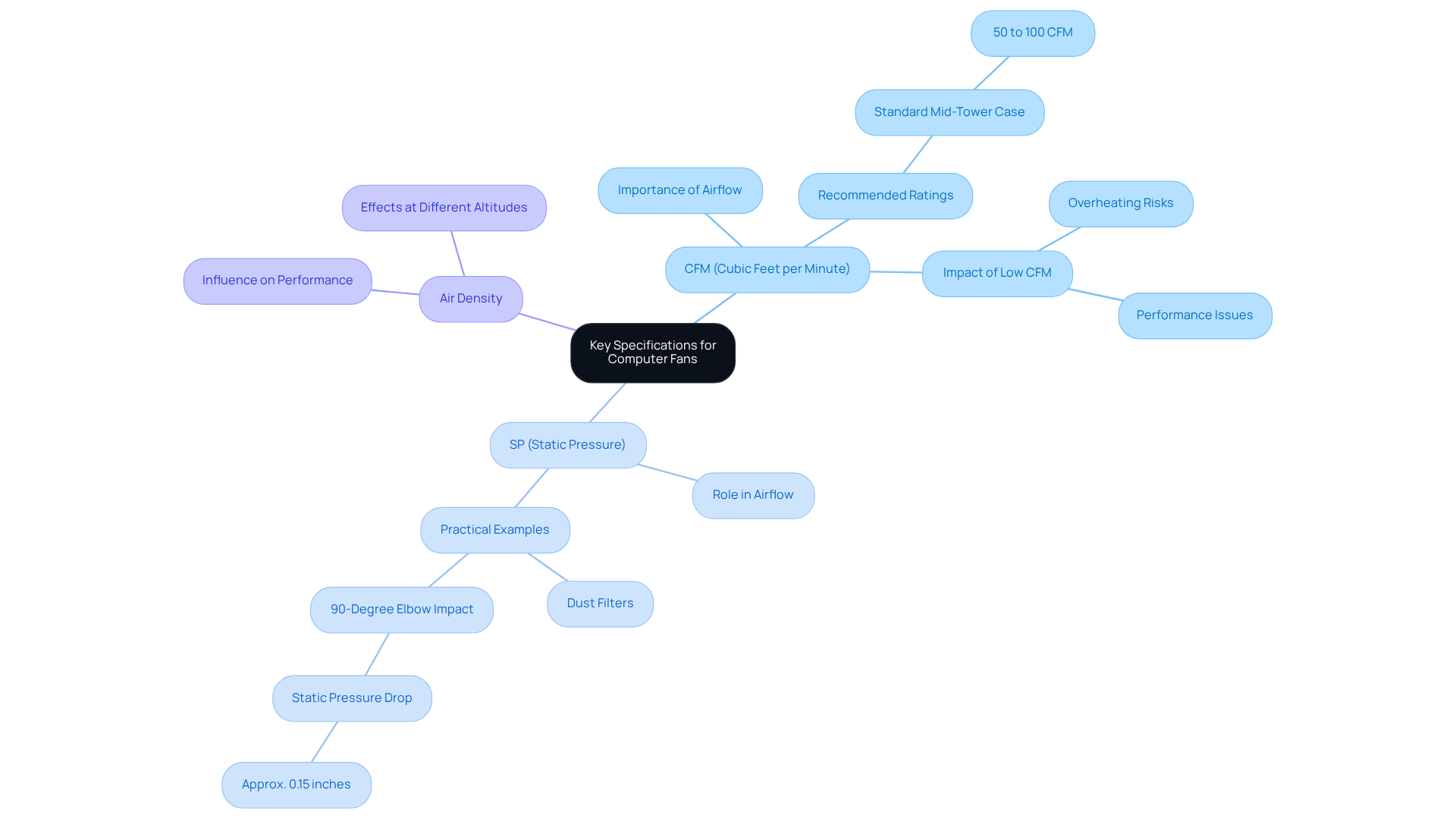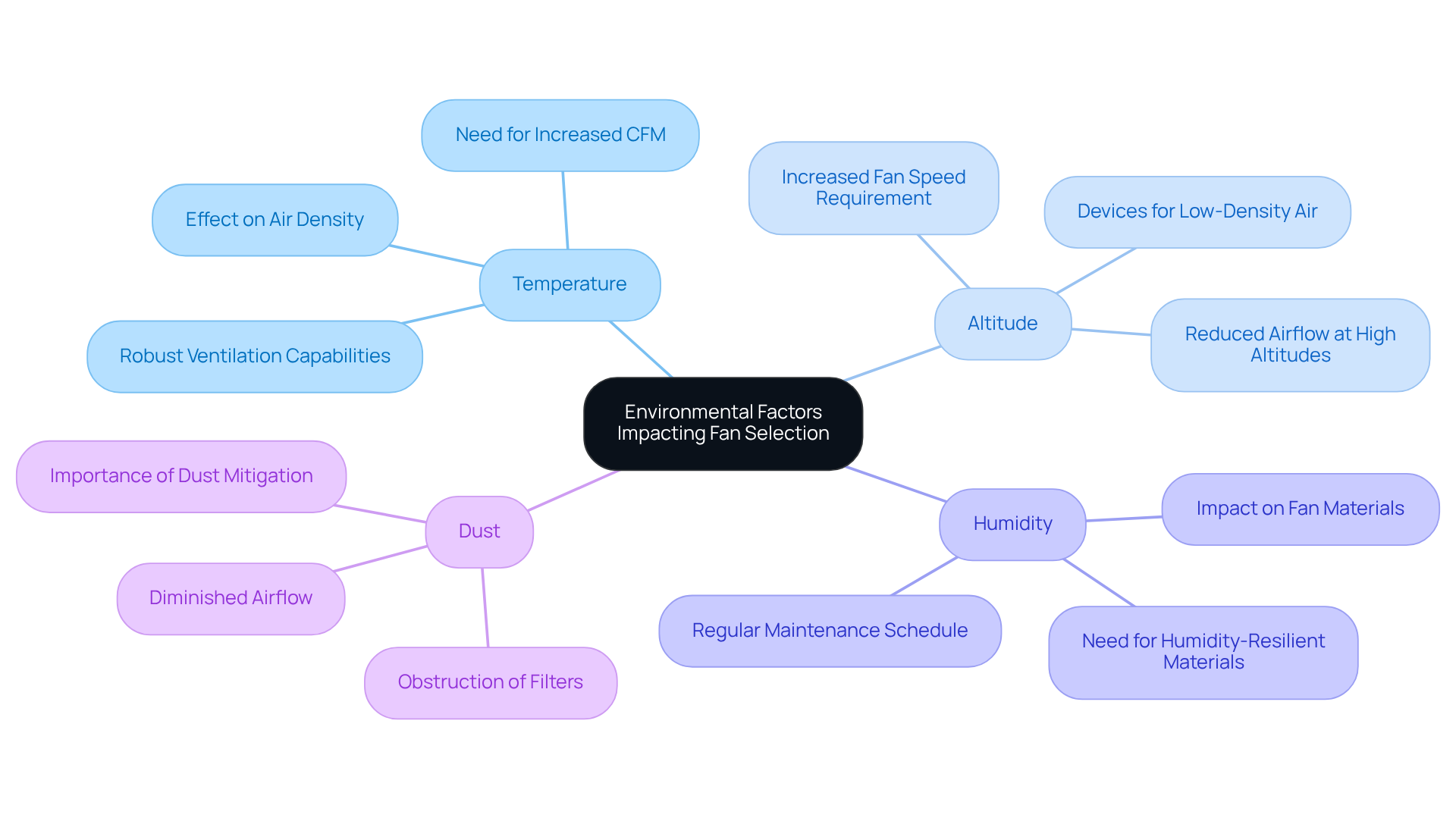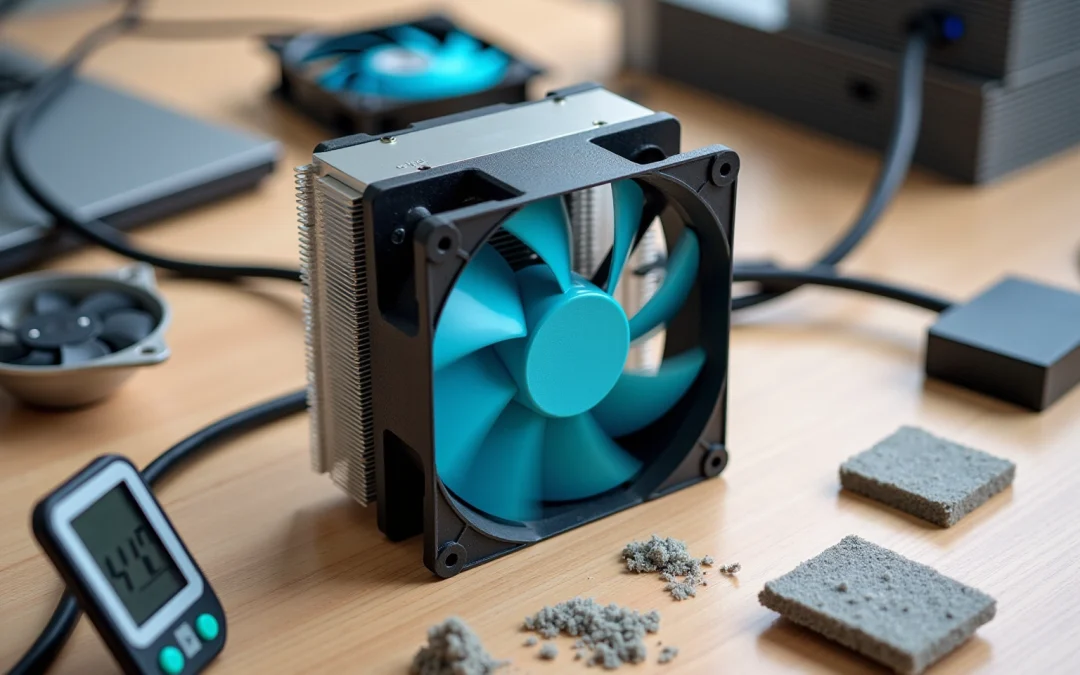Overview
Selecting the appropriate computer fan blower requires a thorough understanding of essential specifications, including:
- CFM
- Static pressure
- Air density
Additionally, environmental factors such as temperature and altitude must be taken into account. These specifications and conditions play a crucial role in fan performance and cooling efficiency. Therefore, it is imperative for users to make informed choices tailored to their specific needs and environmental conditions.
Introduction
Selecting the right computer fan blower is crucial for maintaining optimal performance and preventing overheating in today’s tech-driven environments. This guide delves into essential specifications—CFM, static pressure, and air density—that dictate fan efficiency. Additionally, it addresses environmental factors influencing performance, such as temperature and altitude. As users navigate the complexities of cooling solutions, the challenge remains: how can one ensure they choose a fan that not only meets their immediate needs but also adapts to changing conditions?
Understand Key Specifications: CFM, SP, and Air Density
Selecting the right begins with a clear understanding of :
- CFM (): This metric quantifies the volume of air a fan can move. A higher CFM indicates improved airflow, which is vital for efficiently cooling components. Insufficient airflow resulting from a low CFM can lead to overheating, causing performance issues or hardware damage. For systems generating significant heat, opt for a computer fan blower with an elevated CFM rating, ideally between 50 to 100 CFM for a standard mid-tower case.
- SP (): This measures the fan’s capability to push air through restrictive spaces, such as filters or tight enclosures. A computer fan blower with is essential for systems where airflow is obstructed. For example, if your setup includes dust filters, choose a fan with a high SP rating to ensure consistent airflow. The static pressure drop for a modified 90-degree elbow with two 45-degree angles approximates the 0.15 standard guess, illustrating the practical impact of static pressure on airflow.
- : The density of air significantly influences fan performance. At higher altitudes or temperatures, air density decreases, which may diminish the fan’s effectiveness. Recognizing how air density affects performance is crucial for selecting a fan that operates efficiently in your specific environment.
Additionally, utilizing can , enabling engineers to make informed decisions based on performance data.
By familiarizing yourself with these specifications, you can make informed choices that align with your temperature management needs and system requirements.

Consider Environmental Factors: Temperature and Altitude Adjustments
When selecting a , it is crucial to consider several environmental factors that can impact performance:
- Temperature: , thereby affecting fan performance. In environments where temperatures are consistently high, such as server rooms, it becomes necessary to opt for a fan with an to counteract the decreased efficiency of . A fan with is essential in these scenarios.
- Altitude: At higher altitudes, the decrease in air density can lead to . Consequently, fans may need to operate at increased speeds to deliver the same cooling effect as they would at sea level. For those residing in mountainous regions, it is advisable to consider devices specifically designed to perform effectively in .
- Humidity and Dust: can compromise fan materials and overall performance, while dust accumulation can obstruct filters and diminish airflow. Therefore, selecting devices constructed from materials resilient to humidity is recommended, along with implementing a .
By carefully evaluating these environmental factors, you can select a fan that not only meets your temperature regulation needs but also operates efficiently within your specific conditions.

Locate Local Sales Representatives and Replacement Parts
To effectively locate and replacement parts for your computer fan blower, consider the following steps:
- Research : Begin by identifying nearby distributors or manufacturers specializing in and . Resources such as can connect you with valuable contacts and insights tailored to your needs.
- Contact Sales Representatives: Reach out to local sales representatives who can offer personalized guidance based on your specific temperature control requirements. Their expertise will assist you in navigating product options and recommending the , ensuring you make informed decisions. As noted, “81% of B2B buyers expect sales reps to understand their needs and expectations,” underscoring the importance of .
- Check : Utilize online platforms like Amazon, Newegg, and Micro Center to find a broad selection of . Having the model number of your existing fan will streamline your search for compatible replacements. Keep in mind that the average sales cycle duration has expanded by over 50%, making timely engagement with sales representatives crucial.
- Join Online Communities: Engage with online forums and communities focused on PC building and cooling solutions. Platforms such as Reddit and Tom’s Hardware provide recommendations for and insights from users who have faced similar challenges. Additionally, consider the “Same Day Repair Commitment” case study, which illustrates how prompt service can enhance customer satisfaction.
By following these steps, you can access the right products and support, simplifying the process of selecting and maintaining your computer fan blower. Remember to inquire about warranties for replacement parts, as this can offer added peace of mind.

Conclusion
Selecting the right computer fan blower is a critical decision that directly impacts system performance and longevity. Understanding key specifications such as CFM, static pressure, and air density is essential for choosing a fan that effectively meets cooling needs. Additionally, considering environmental factors like temperature and altitude is crucial for optimizing fan performance under various conditions.
The significance of evaluating these specifications and environmental considerations cannot be overstated. A higher CFM is vital for ensuring adequate airflow, while static pressure is essential for overcoming airflow restrictions. Moreover, being aware of how air density changes with temperature and altitude will guide users in selecting the most suitable fan for their specific environments.
However, the selection process extends beyond understanding specifications; it also involves locating reliable local sales representatives and replacement parts. Engaging with knowledgeable suppliers and utilizing online resources can simplify the purchasing journey. By taking these steps, individuals can enhance their computer systems’ cooling efficiency and performance, ensuring optimal operation for years to come.
Frequently Asked Questions
What does CFM stand for and why is it important in selecting a computer fan blower?
CFM stands for Cubic Feet per Minute, which quantifies the volume of air a fan can move. A higher CFM indicates improved airflow, essential for efficiently cooling components. Insufficient airflow from a low CFM can lead to overheating and performance issues.
What is the recommended CFM rating for a standard mid-tower case?
For a standard mid-tower case, it is ideal to opt for a computer fan blower with a CFM rating between 50 to 100.
What does SP represent in the context of computer fans?
SP stands for Static Pressure, which measures a fan’s capability to push air through restrictive spaces, such as filters or tight enclosures. A fan with high static pressure is essential for systems where airflow is obstructed.
Why is high static pressure important for setups with dust filters?
High static pressure is important for setups with dust filters because it ensures consistent airflow despite the obstruction caused by the filters.
How does air density affect fan performance?
Air density significantly influences fan performance; at higher altitudes or temperatures, air density decreases, which may reduce the fan’s effectiveness. Understanding this impact is crucial for selecting a fan that operates efficiently in specific environments.
What can help streamline the selection process for computer fans?
Utilizing fan selection software can streamline the selection process, allowing engineers to make informed decisions based on performance data.
How can understanding CFM, SP, and air density help in fan selection?
Familiarizing yourself with these specifications allows you to make informed choices that align with your temperature management needs and system requirements.

